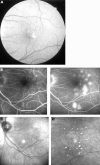Subthreshold (retinal pigment epithelium) photocoagulation in macular diseases: a pilot study
- PMID: 10611098
- PMCID: PMC1723228
- DOI: 10.1136/bjo.84.1.40
Subthreshold (retinal pigment epithelium) photocoagulation in macular diseases: a pilot study
Abstract
Background: Subthreshold (retinal pigment epithelium) photocoagulation is a new photocoagulation method, which treats the retinal pigment epithelium (RPE) and avoids damage to the neural retina. The initial results in this prospective pilot study on various macular diseases are presented.
Methods: 12 patients with diabetic maculopathy (group I), 10 with soft drusen (group II), and four with central serous retinopathy (CSR) (group III) were treated and followed up for 1 year. Treatment was achieved using a train of repetitive short laser pulses (1.7 micros) of a green Nd:YLF laser (parameters: 527 nm, 100 and 500 pulses, repetition rate: 500 Hz, spot size: 160 microm, energies: 70-100 microJ). Laser energy was based on the visibility of test lesions on fluorescein angiography (50-130 microJ). Patients were examined at various times by ophthalmoscopy, fluorescein and ICG angiography, and infrared imaging.
Results: After 6 months hard exudates disappeared in six out of nine patients in group I and leakage disappeared in six out of 12 diabetic patients. In group II drusen were less in seven out of 10 patients. In group III serous detachment disappeared in three out of four cases. Visual acuity was stable in all cases. None of the laser lesions was clinically visible immediately. After 1 day most lesions were visible as yellowish RPE depigmentation. After 3 months some of the lesions were visible as hyperpigmented areas but most were not. Fluorescein angiography showed leakage only in the first week. Infrared imaging showed that most lesions can be visualised in groups I and II after a period longer than 1 week as hyperreflective areas.
Conclusion: This study showed that subthreshold (RPE) photocoagulation is effective in some cases of diabetic maculopathy, drusens, and in CSR. Visibility of laser burns is not always necessary in the treatment of macular diseases presented here. Infrared imaging is an effective and non-invasive way of visualising subthreshold (RPE) laser burns.
Figures








References
MeSH terms
LinkOut - more resources
Full Text Sources
Other Literature Sources
Medical
